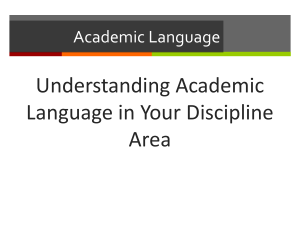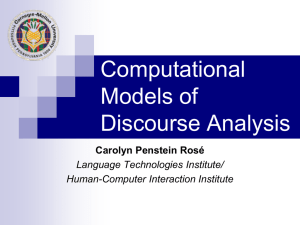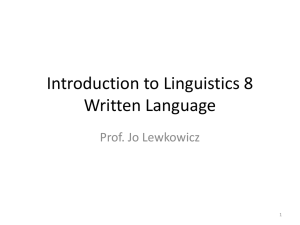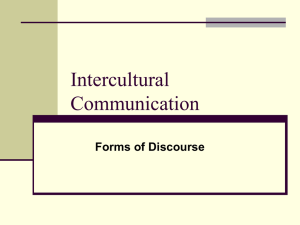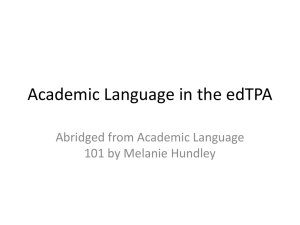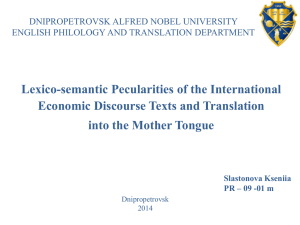Academic Language and the edTPA
advertisement
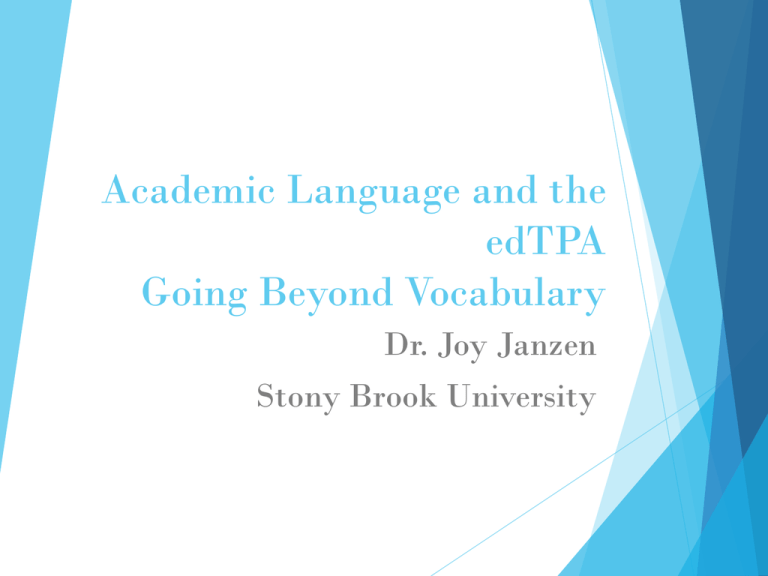
Academic Language and the edTPA Going Beyond Vocabulary Dr. Joy Janzen Stony Brook University Is vocabulary knowledge all there is to academic language? by Conventions in three fourths thereof which may be made prior to the Year One thousand eight hundred and eight shall call a Convention for proposing Amendments, which, in either Case, shall be valid to all Intents and Purposes, as Part of this Constitution shall be deprived of its equal Suffrage The Congress, in the Senate. whenever two thirds of both Houses shall deem it necessary, no Amendment shall in any Manner affect the first and fourth Clauses in the Ninth Section of the first Article shall propose Amendments to this Constitution, or, on the Application of the Legislatures of two thirds of the several States when ratified by the Legislatures of three fourths of the several States, or as the one or the other Mode that; and that no State, without its Consent Does it help you to understand this scrambled sentence if you know the meaning of the word suffrage? Grammar? (Eeek!!!) Students in middle and high school must be able to make sense of dense, complex sentences. How a sentence is put together, what parts come first or second, and what parts belong to other parts are critical aspects of academic language. In short, learners must understand what the edTPA calls syntax: “(t)he set of conventions for organizing symbols, words, and phrases together into structures (e.g., sentences, graphs, tables).” But that’s not all . . . Understanding academic language means understanding how information is organized and presented within a discipline. The edTPA calls this level of language, discourse, and defines discourse as: “the structures of written and oral language, as well as how members of the discipline talk, write, and participate in knowledge construction. Discipline-specific discourse has distinctive features or ways of structuring oral or written language (text structures) that provide useful ways for the content to be communicated.” So what do syntax and discourse mean for teacher candidates struggling to figure out the edTPA? To answer that question, we need to look at two more terms that the edTPA uses: language function and language demand. Language Function • What kind of thinking, reading, writing, listening, and speaking are we expecting in the classroom? • Do we want students to explain, categorize, compare or evaluate? Or something else? Math Describe Science History ELA Social studies EAL Analyze Analyze Analyze Argue Argue Describe Describe Analyze Describe Evaluate Evaluate Explain Explain Explain Explain Language Demand Language demand arises from the lesson focus combined with the language function. In other words, given what teacher candidates are asking students to do (language function), what kind of language do they need? Of course they need vocabulary, but the edTPA specifically asks teacher candidates to go beyond vocabulary and also consider syntax and discourse (Rubric 4, Identifying and Supporting Language Demands). Academic Language in the Planning Sequence 1. Identify a central focus for instruction. 2. Consider who the students are and what they need. 3. Choose a language function appropriate for the content, focus, and students. 4. Given the language function, identify language demands. Language demands must include vocabulary, as well as either syntax or discourse. Language Function and Language Demand in Mathematics vs. English Language Arts (ELA) Both mathematics and ELA list “explain” as a potential language function. Assume, for a moment, that for students to explain in a particular lesson, they need to read and understand the following texts. How can we describe the language demand in each case? Text A (Mathematics): A group of friends went to lunch. The bill, before sales tax and tip, was $37.50. A sales tax of 8% was added. The group then tipped 18% on the amount after the sales tax was added. What was the amount, in dollars, of the sales tax? (from Grade 7 Common Core Mathematics Test) Text B (ELA): I sent the invitation to Ben and Carmela two weeks ago. They said yes, then invited Georgia to come, without asking me if it was all right. Because of course it wasn’t all right. I hate Georgia, I’ve always hated her, and I always will. And one of the main reasons I hate her is what happened at the end of lunch. We went to this noodle restaurant, and the food was fine. Not splendid or sumptuous or splendiferous, but fine. No birds in the bird’s nest soup. Okay, so I’m setting the bar low. Whatever. And then it happened. It always happens when Georgia goes out to lunch. The waiter brings the check, I start to calculate how much everybody owes. And, wham, Georgia opens her purse and announces she’s forgotten her wallet at home. The two texts have the same topic (more or less): going out to lunch with friends and paying for the meal. They differ in several ways, one of which, of course, is vocabulary (amount, sales tax vs. sumptuous, splendiferous). They also differ in terms of how the individual words are put together into sentences (syntax) and how the sentences fit into a larger text (discourse). Narratives such as Text B are frequently organized chronologically, but math problems do not have to be. Syntax Rules English has many syntactical rules that determine how words are organized into phrases and sentences. For example, the sentence A sales tax of 8% was added consists of a noun phrase (the sales tax of 8%) plus a verb phrase (was added). In English statements (not questions), we usually put the noun phrase before the verb phrase. So we would write A group of friends (noun phrase) went to lunch (verb phrase) rather than Went to lunch a group of friends. Do We Really Have to Teach Syntax???? • My students already know English grammar. • Besides, it’s somebody else’s job. • Well, maybe English Language Learners need some help. • Complexity of academic language and literacy Long Noun Phrases Consider this math problem: Last week Len spent $18 to bowl 4 games. This week he spent $27 to bowl 6 games. Len owns his bowling ball and shoes, so he only has to pay for each game that he bowls. If each of these bowling games costs the same amount of money, what is the constant of proportionality between the money spent and the number of games played? (from Grade 7 Common Core Mathematics Test) What happened to discourse? The definition of discourse in the edTPA is very broad. It includes language structures typical of a particular discipline, as well as how “members of the discipline talk, write, and participate in knowledge construction.” Scaffolding student discourse, then, could mean using familiar teaching techniques such as anticipation guides, graphic organizers, or discipline-targeted note-taking. Discourse in the Sciences In a math or physics or chemistry problem, discourse requires an ability to move between multiple types of representation. Students have to read a short text that’s written primarily in words but may also include numbers, symbols and equations. To solve a problem, they usually write an equation only in numbers and variables. Helping students to make connections among English words, mathematical/ science concepts and equations is a discourse issue. (For a detailed examination of how this can be done in math, look at Reading in secondary content areas by Fang and Schleppegrell.) Earth Science Similarly, in earth science, students have to make sense of complicated reference tables (a form of science discourse), and they have to use these tables to answer questions such as: Complete the pie graph in your answer booklet to show the percent by volume of nitrogen and oxygen gases currently found in Earth’s troposphere (from January 2010 Regents Examination). English Language Arts • Text structure • Genre • Cognitive/metacognitive strategies History/Social Studies • Text structure • Time markers and connectors (in 1814, After the election of Andrew Johnson, prior to the outbreak of World War I) • Reference devices (pronouns, synonyms) History Example The words in red below refer to the Louisiana purchase, while the words in blue refer to the Federalists (excerpted from the August, 2013 Regents). When news of the [Louisiana] purchase reached the United States, President [Thomas] Jefferson was surprised. He had authorized the expenditure of $10 million for a port city, and instead received treaties committing the government to spend $15 million on a land package which would double the size of the country. Jefferson’s political opponents in the Federalist Party argued that the Louisiana purchase was a worthless desert, and that the Constitution did not provide for the acquisition of new land or negotiating treaties without the consent of the Senate. What really worried the opposition was the new states which would inevitably be carved from the Louisiana territory, strengthening Western and Southern interests in Congress, and further reducing the influence of New England Federalists in national affairs. President Jefferson was an enthusiastic supporter of westward expansion, and held firm in his support for the treaty. Despite Federalist objections, the U.S. Senate ratified the Louisiana treaty in the autumn of 1803.... English as an Additional Language In the EAL handbook, language demands beyond vocabulary fall into four categories of competence: 1. grammatical (vocabulary and structure) 2. pragmatic (“appropriate use of communication strategies”) 3. discourse (“cohesion and coherence,”) 4. metalinguistic competence is defined as “language learning strategies” Confusingly, grammatical competence includes vocabulary as well as structure. EAL, continued As with content-area teachers, EAL teachers may want to help their students make sense of complex text or produce texts that are geared towards a particular audience for a particular purpose (these goals would fit under grammatical or discourse competence). Though all students need to be able to understand and use oral academic language, emphasis on speaking and listening may be particularly important for English Language Learners (ELLs). ELLs may need assistance in pragmatic competence: how to politely disagree with a classmate in a small group setting or how to ask a question appropriately in the classroom. It’s important to note, though, that instruction in the structure of questions in general would fall under grammatical competence. Focus on Academic Language in Teacher Preparation • The medium is the message (tasks that can be adapted by teacher candidates for use in their own classrooms; explicit discussion of the challenges of reading academic text and what helps them to do it) • Language analysis (breaking down pieces of academic language that might be used in middle or high school classes) • Microteaching Evidence? Teacher Candidates and the edTPA In the best of worlds, the edTPA would be an opportunity for teacher candidates to think again about how they make sense of complex text in their disciplines. Analyzing, explaining, and justifying all require language. Academic vocabulary doesn’t have the same meanings in every field. Knowledge isn’t organized and presented in the same way in every field. Teaching and learning about academic language doesn’t have to and shouldn’t be an addition to a curriculum that’s already too full. Teaching students to make sense of academic language should be teaching them how to be independent and engaged learners. Resources for Understanding Language in the Content Areas Fang, Z. & Schleppegrell, M. (2010). Disciplinary literacies across content areas: Supporting secondary reading through functional language analysis. Journal of Adolescent and Adult Literacy, 53 (7), 587-597. Fang, Z. & Schleppegrell, M. (2008). Reading in secondary content areas. Ann Arbor: University of Michigan Press. Schleppegrell, M. J. (2007). The linguistic challenges of mathematics learning and teaching: a research review. Reading & Writing Quarterly, 23, 139-159. Schleppegrell, M. & de Olivera, L. (2006). An integrated language and content approach for history teachers. Journal of English for Academic Purposes, 5 (4), 254-268. Teaching Academic Language Schoenbach, R., Greenleaf, C. & Murphy, L. (2012). Reading for understanding. San Francisco: Jossey-Bass. Zwiers, J. (2008). Building academic language. Essential practices for content classrooms. San Francisco: Jossey-Bass. CAVEAT/WARNING The edTPA’s definitions of syntax and discourse are ambiguous. It appears that the distinction they’re making between syntax and discourse is the one that’s traditionally made in the field of linguistics, where syntax focuses on the structures of clauses and sentences, and discourse examines larger pieces of text. But, for example, the handbooks also list the structure of graphs and tables under syntax. So it could be that their equation is Sentence in essay = graph in science or math What is NOT ambiguous, however, is the distinction that Rubric #4 (Identifying and Supporting Language Demands) makes between language demands that only include vocabulary and language demands that go beyond vocabulary. To reach the more proficient levels (3-5), a candidate must identify language demands in addition to vocabulary. reparations, republic, rebellion, refraction, ratio, rational, reciprocate, recoil, reproduction, resistant, retrograde, rhetoric, rotund, rhombus, rumpus, ribonucleic, RADICAL Radical??? •Someone from the 1960s? •A free radical in chemistry? •A root? Vocabulary Vocabulary is an essential—and familiar--component of academic language. Research suggests that children in school studying in their native language learn somewhere between 1,000 and 5,000 words per year; most estimates put the total between 2,000 and 4,000. Fluent readers graduating from high school know approximately 40,000 words (Grabe, 2009). Resources Academic language is complex and, for that reason, teaching academic language in the content areas is also complex. There are many reports and articles that define and describe academic language, and the list below includes some of those. Resources that focus on how to teach academic language or how to incorporate language analysis into instruction are less easy to identify. Some of the sources I list in the next slides are taken from the field of systemic functional linguistics. This approach to language looks at how language varies according to audience, purpose, and context and how language choices work to create meaning. Why, for example, do procedural sections of lab reports use passive voice? Many of the writers and researchers in systemic functional linguistics are particularly interested in the role of language in education, but grasping their arguments requires teacher candidates to engage in their own explorations of complex text. History/Social Studies In history/social studies, discourse can, again, include understanding the structure of texts. History texts are frequently organized chronologically with words or phrases that signal that organization and also function to tie the text together (in 1814, After the election of Andrew Johnson, prior to the outbreak of World War I). Helping students pay attention to these signaling words can help them understand the meaning of texts. Another way that texts are tied together into coherent discourse is through use of reference devices such as pronouns and synonyms. Scaffolding students to follow chains of reference through the text can help them comprehend what they’re reading (Schleppegrell & Achugar, 2006). But that’s not all . . . Students in middle and high school must also be able to make sense of longer pieces of text including original documents, reference tables, essays, novels, multiple choice tests, word problems, maps, graphs, poems, equations (and much more). Understanding academic language means understanding how information is organized and presented within a discipline. The edTPA calls this level of language, discourse, and defines discourse as: “the structures of written and oral language, as well as how members of the discipline talk, write, and participate in knowledge construction. Discipline-specific discourse has distinctive features or ways of structuring oral or written language (text structures) that provide useful ways for the content to be communicated.” ELA • In English language arts, teacher candidates are usually familiar with language demands in terms of text structure—and text structure is a critical aspect of discourse. Literary texts such as different types of poetry may have distinct text structures (sonnets, for example). The types of texts that students produce also frequently have particular types of organization. Texts or genres written in ELA vary widely according to audience and purpose; helping students to understand the nature of that variation is part of discourse. But discourse also includes thinking in ways valued by an individual discipline. For example, when reading complex texts in an ELA classroom, students should be very active readers, using strategies such as asking questions of the text, the author, and themselves, making connections, and paraphrasing/summarizing as they read. Teaching students discourse in an ELA classroom could mean helping students expand their repertoires of cognitive and metacognitive strategies. (See Reading for Understanding in the resources list.) ELA, continued But discourse also includes thinking in ways valued by an individual discipline. For example, when reading complex texts in an ELA classroom, students should be very active readers, using strategies such as asking questions of the text, the author, and themselves, making connections, and paraphrasing/summarizing as they read. Teaching students discourse in an ELA classroom could mean helping students expand their repertoires of cognitive and metacognitive strategies. (See Reading for Understanding in the resources list.) Do We Really Have to Teach Syntax???? It may seem to teacher candidates that syntactical knowledge will be deeply engrained by the time their students get to middle and high school, even if those students are not explicitly aware of grammar rules. Alternatively, if students don’t know these rules, then it’s the ELA or English as an Additional Language (EAL) teacher’s job to address them. But, of course, grammar knowledge may not be very deeply engrained for English learners—and addressing the needs of all students is part of what the edTPA is assessing. Also, even when students are native English speakers, the syntax of academic language can present a challenge. English as an Additional Language Teacher candidates in EAL may need to grapple with academic language in all of the content areas to help their students, but they are asked to consider language demands in a different way from syntax and discourse. In the EAL handbook, language demands beyond vocabulary fall into four categories of competence: grammatical (vocabulary and structure); pragmatic (“appropriate use of communication strategies;)”, discourse (“cohesion and coherence,”) while metalinguistic competence is defined as “language learning strategies.” Confusingly, grammatical competence includes vocabulary as well as structure. Earth Science Similarly, in earth science, students have to make sense of complicated reference tables (a form of science discourse), and they have to use these tables to answer questions such as: Complete the pie graph in your answer booklet to show the percent by volume of nitrogen and oxygen gases currently found in Earth’s troposphere (from January 2010 Regents Examination). This question includes a long noun phrase (percent by volume of nitrogen and oxygen gases currently found in Earth’s troposphere). Chunking this question into parts could be a syntactic issue; scaffolding students to move between the language of the question and the table itself is a discourse issue.

